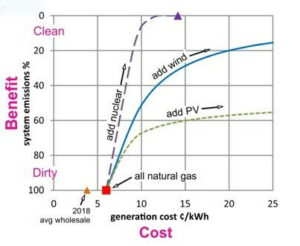Maryland now has a sound clean energy goal: 100 percent clean electricity by 2040. This goal is smart because it specifies a clear purpose: reliable, affordable, clean electricity; no greenhouse gas emissions by whatever sustainable technology proves to be cost effective.
The goal is technology agnostic; it does not guess at technology solutions. One hundred percent clean is a simple stable ultimate performance goal. It is essential to achieve this goal because other sectors (such as plugin electric vehicles) rely on clean electricity to be effective. Now that Maryland’s goal is zero greenhouse gas emissions (100 percent clean), the next task is a cost/benefit assessment of alternative system designs.
Everybody sees the clean generator technology options: wind (onshore and offshore), solar, hydro, nuclear, geothermal-electric and sequestration. But simply comparing generator technology is inadequate because different generators impose different system constraints. Most people understand that it is not possible to swap wind farms for coal plants and maintain system reliability because when wind falls to zero it goes to zero everywhere at the same time, often during peak load.
The serious question is how do these clean generators fit together to configure systems that deliver reliable affordable power when and where it is needed.
So imagine the design of whole new PJM systems. The DoE Energy Information Agency provides new generator construction costs. We know the load and weather from historical data. To keep it simple we initially assume perfect (no cost, no loss) transmission.
 The adjacent chart illustrates results for three two-component systems: 1) natural gas + nuclear; 2) n-gas + wind, and 3) n-gas + PV. The horizontal axis is the combined cost of all the generators in cents/kWh. The vertical axis is the emission benefit measured as a percentage of a natural gas system. The reference system (red square) is 100 percent natural gas, consisting of enough combined cycle generators to satisfy peak load plus 15 percent reserves consisting of combustion turbine generators. These generators have a combined system cost of 6 cts/kWh (excluding transmission and distribution).
The adjacent chart illustrates results for three two-component systems: 1) natural gas + nuclear; 2) n-gas + wind, and 3) n-gas + PV. The horizontal axis is the combined cost of all the generators in cents/kWh. The vertical axis is the emission benefit measured as a percentage of a natural gas system. The reference system (red square) is 100 percent natural gas, consisting of enough combined cycle generators to satisfy peak load plus 15 percent reserves consisting of combustion turbine generators. These generators have a combined system cost of 6 cts/kWh (excluding transmission and distribution).
As nuclear power plants are added to the natural gas the cost/benefit of the n-gas + nuclear system tracks the purple long-dash curve. All the system cost/benefit curves swoop to the right because a mismatch between generation and load forces some generators to shut down (curtailment). For nuclear, this occurs due to diurnal (day/night) load variations. For wind and solar curtailment occurs mainly due to over generation. For PJM wind, excess generation curtailment begins at 25 percent penetration (75 percent emissions) but does not accelerate system cost increases until 50 percent penetration. Wind generators alone cannot get to zero system emissions without costly seasonal storage. The serious Solar PV constraint is rapid ramping beginning at 10 percent penetration (the sun sets at 6 p.m. and it is necessary to rapidly ramp up the fossil fuel generators).
The chart is intended to illustrate what a system level cost/benefit study would look like. A thorough PJM concept design study would include systems with offshore wind, sequestration and geothermal electric generators. It would include the impact of storage, transmission realities, ramping inefficiencies, dispatch rules, and ancillary system costs. It would include generator combinations, multi-year sensitivity and parameter (cost) sensitivity.
Now that we have a sound goal, a rigorous cost/benefit analysis is essential to show that today’s investments do not interfere with the ability to achieve that goal.
—ALEX PAVLAK
The writer is a PhD professional engineer who has led the successful development of major new military systems. He is a former president of a solar collector development company and is now the chairman of the Future of Energy Initiative.
Did someone forward this to you?
Get your own daily morning news roundup in your inbox. Free. Sign up here.




 Creative Commons Attribution
Creative Commons Attribution